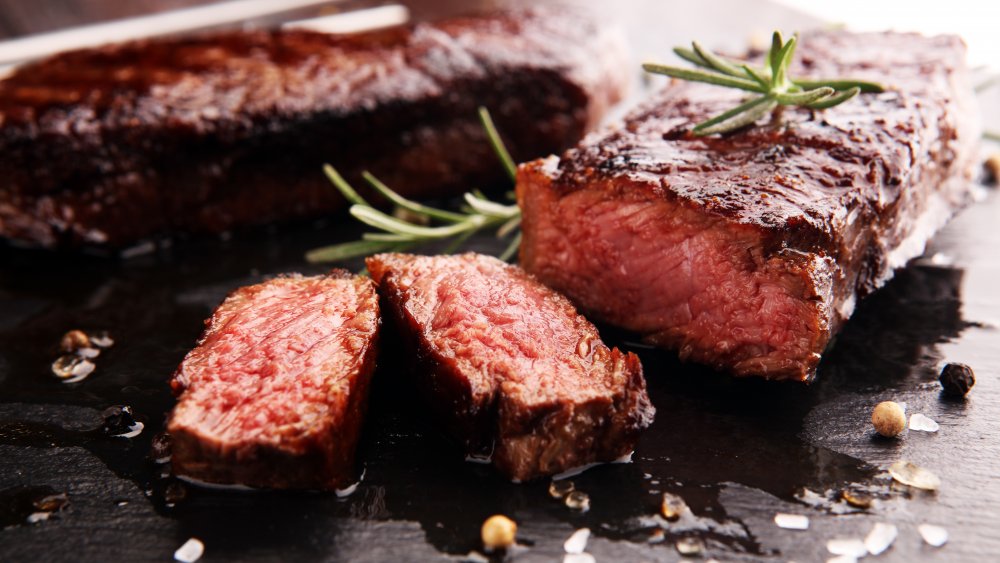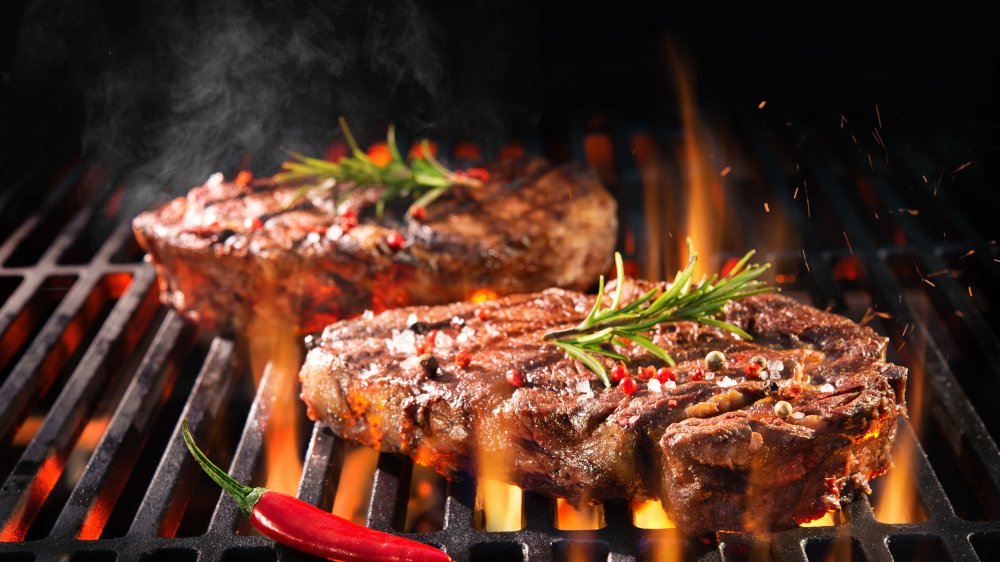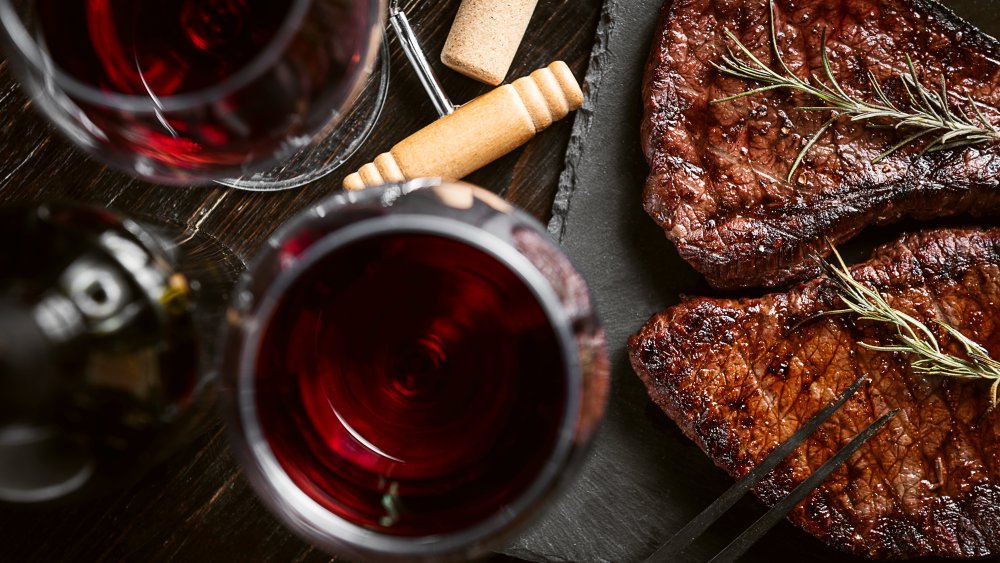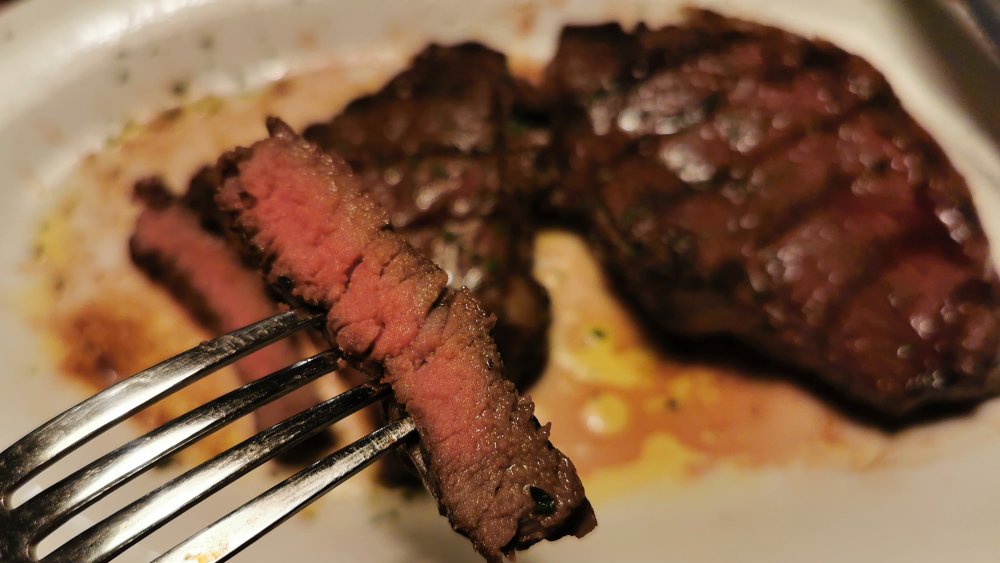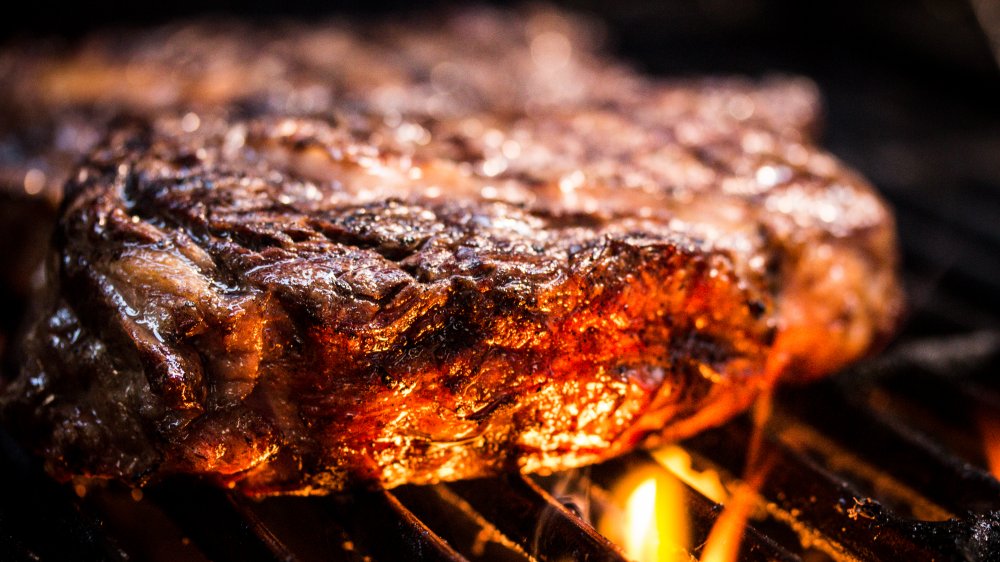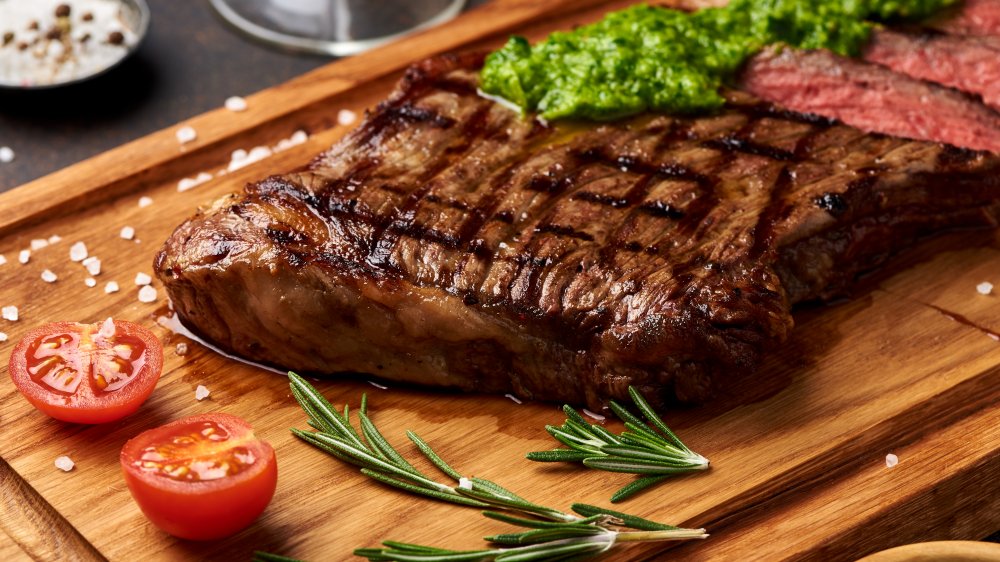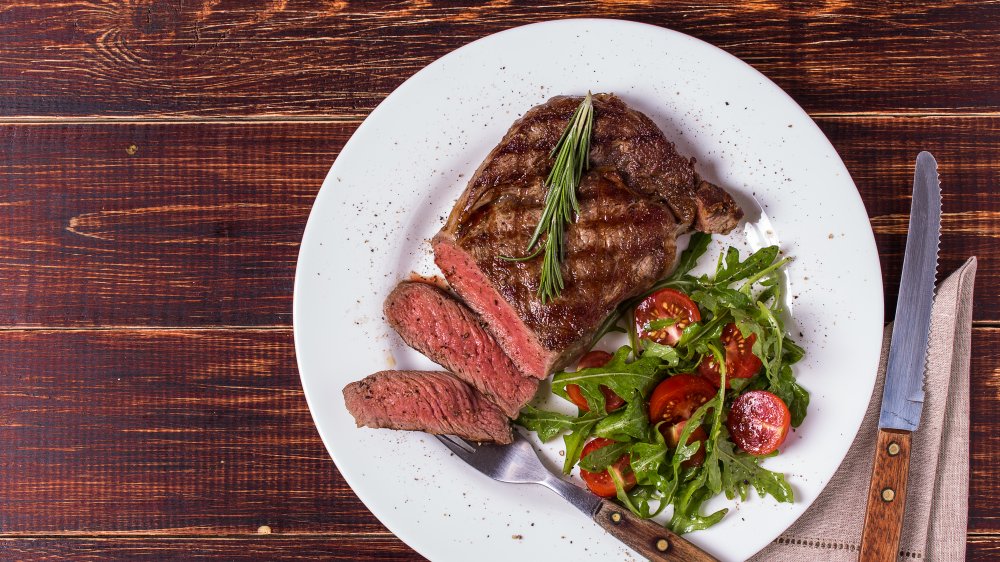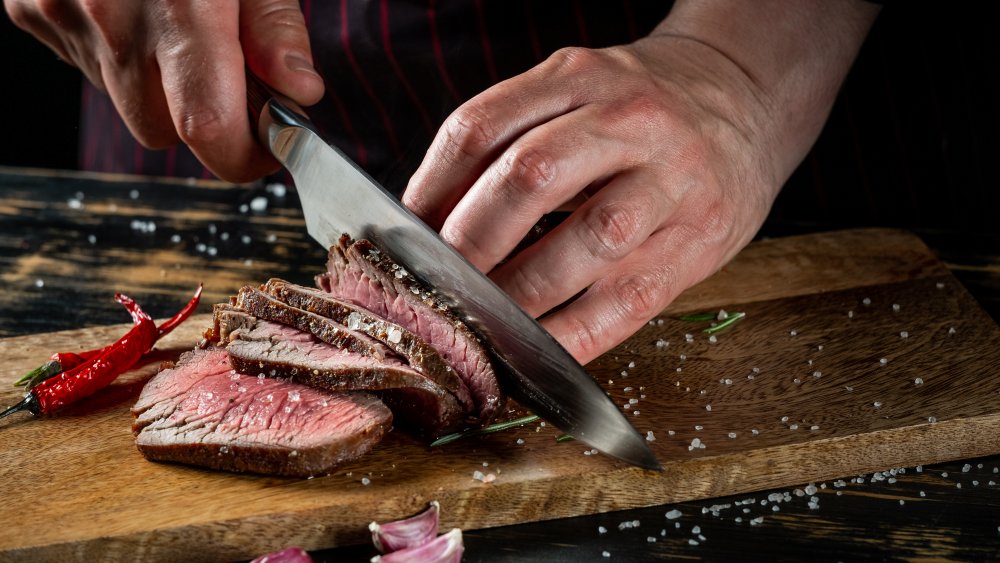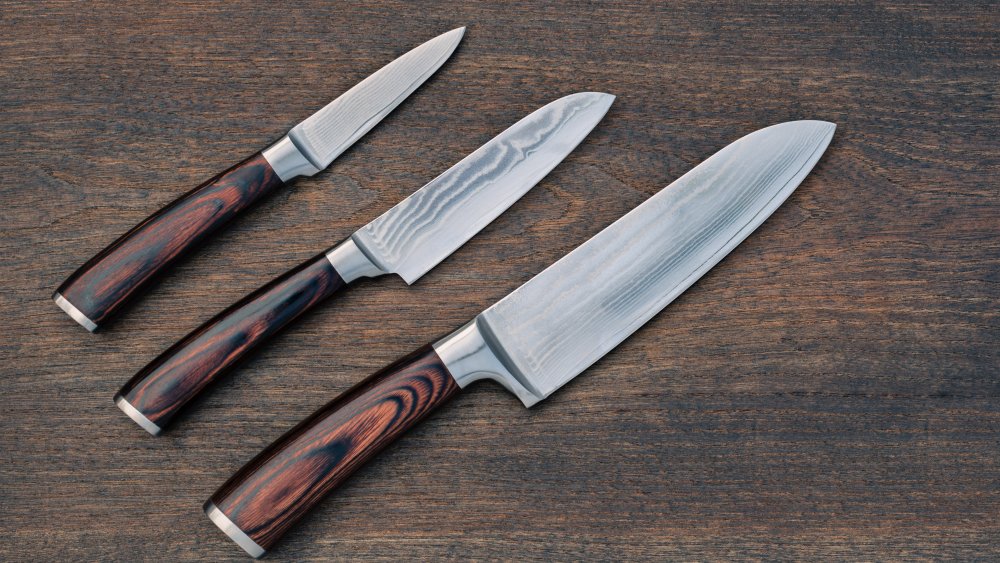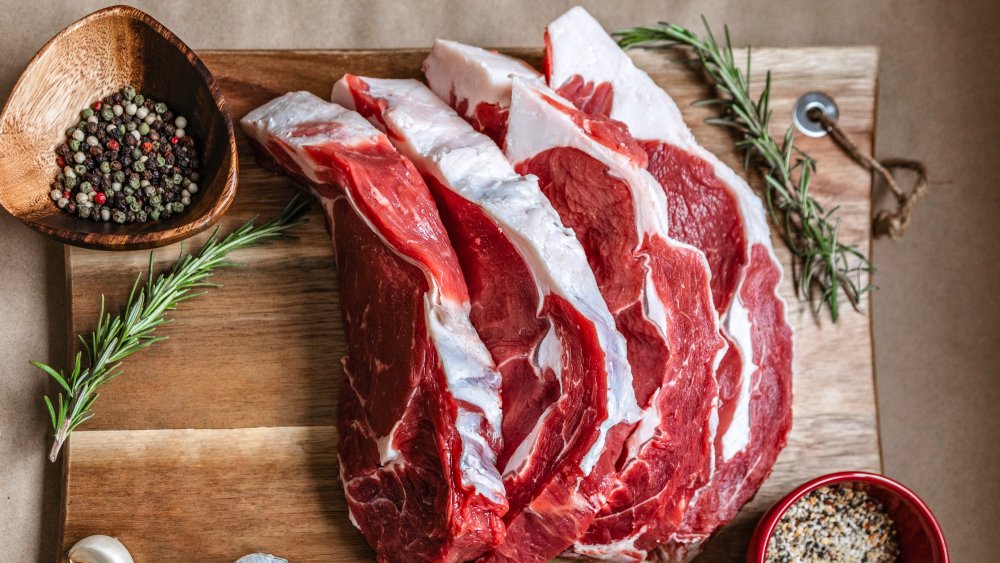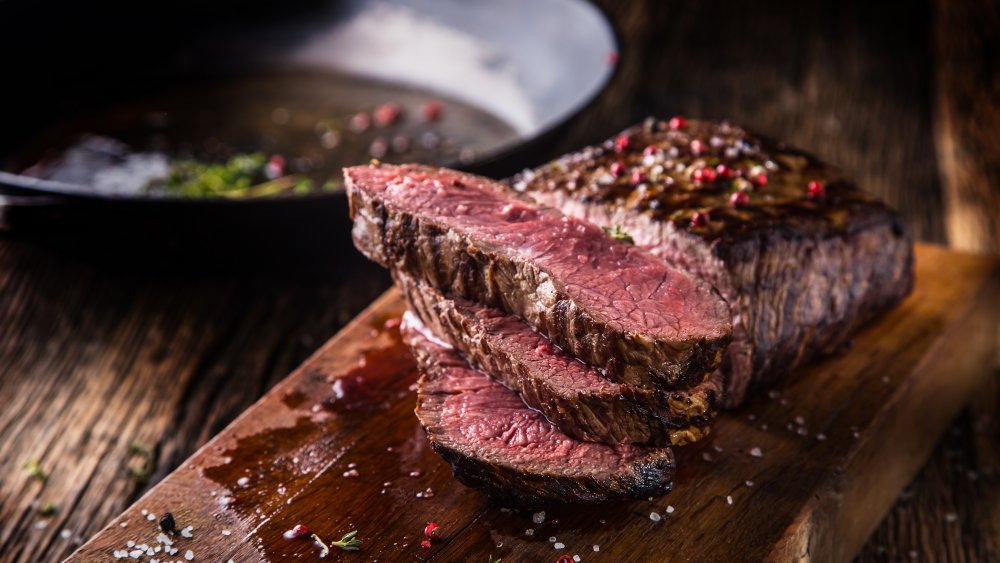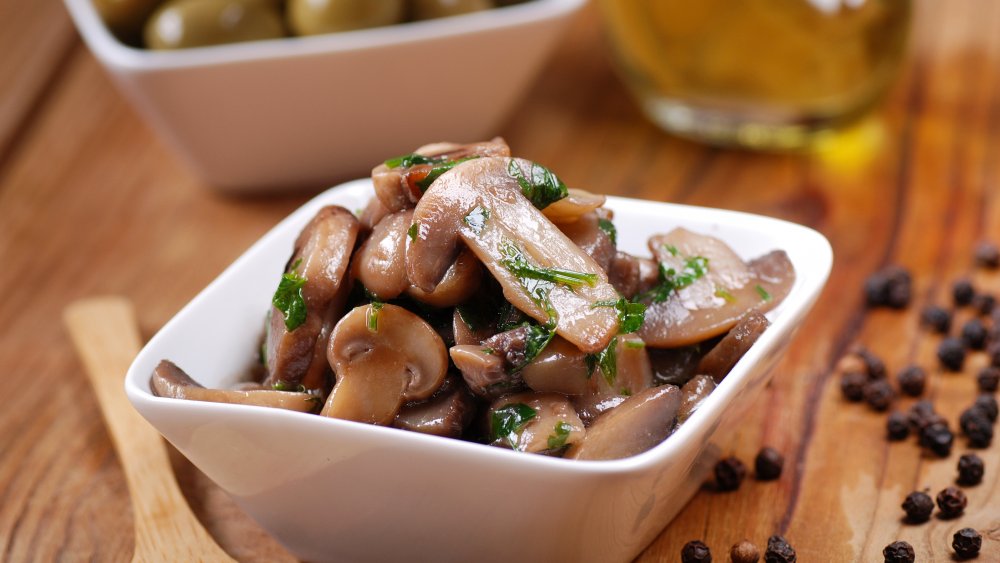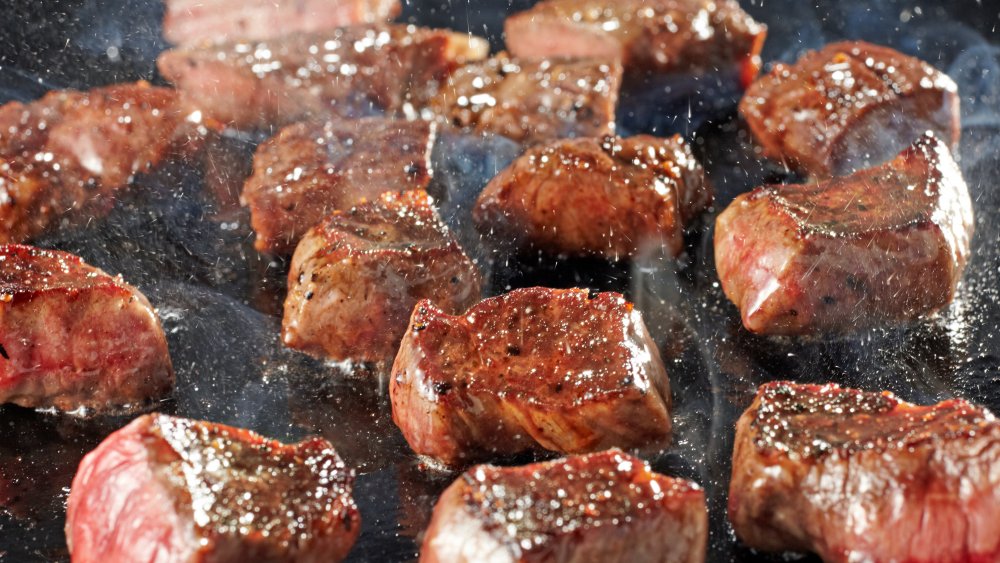Mistakes Everyone Makes When Eating Steak
You might assume that eating a steak is pretty simple — you use your knife and fork to cut into your meat, take a bite, chew, swallow, and dab your mouth with your napkin. Voila! Rinse and repeat.
But in reality, eating steak can be trickier than you might initially think. Even if you've been eating steak your whole life, there's a good chance you're still making a few mistakes here and there.
If you're going to be eating an expensive cut of meat like steak, there are a few dos and don'ts you should know about before you dig in. From proper steak etiquette rules to seasoning advice to important food safety tips, there are lots of little ways your steak could trip you up while you're eating it, whether you're at home or a restaurant.
Curious to know if you've been eating steak wrong your whole life? Read on so you don't make these mistakes while eating steak again.
Eating your steak with the same utensils you prepared it with
If you're grilling your own steak, chances are you used at least a handful of kitchen items from start to finish. There's the plate you set the steaks on, the fork you used to turn them over during seasoning, the tongs you used to get them situated on the grill — maybe even a grill spatula to flip them over while cooking and a sharp knife to cut into one to check the doneness.
But be careful when you head back into the kitchen and start plating up your meal. You never, ever, ever want to use the same utensils or plates that you used when the meat was still raw. We all know this sanitation fact and yet, accidents happen. Maybe you're cooking with someone else and they don't realize that a plate you set on the counter once contained raw meat. Perhaps you just plain forgot which fork you used. In fact, the Centers for Disease Control and Prevention says putting cooked meat back on a plate that held raw meat is one of the top 10 food safety mistakes people make.
Your best bet? Stash anything that touched raw meat right in the dishwasher or in a sink full of hot, soapy water right away to prevent any confusion.
Pairing your steak with the wrong wine
Sure, steak is just plain delicious on its own. It's savory, hearty, salty, and juicy — especially when seasoned and cooked to perfection. Just throw in a few side dishes and you're good to go.
But never underestimate the power of a good wine pairing when it comes to eating steak. Choosing the right wine can sometimes feel like rocket science, but it doesn't have to be that way, once you learn a broad overview of the different types of wine on the market. Plus, a good wine pairing can drastically improve (or degrade!) your experience during your meal. If you're serious about eating steak, it's worth your time to do a little research the next time you're at the liquor store.
If you just can't tell a Cabernet Sauvignon from a Merlot, never fear. There are some easy wine pairing rules to keep in mind, according to Food & Wine. In general, if you're eating red meat, you should look for a red wine. Simple enough, right? This is because your steak can handle and even complement the big, bold flavors of a red wine. Red wines tend to be higher in tannins, a type of bitter flavor compounds, which pair well with the fat and salt of your steak.
Cutting your steak all at once
If you're the type of person who sees a meal as a challenge that needs to be overcome as quickly as possible, put down your fork and knife and back away from the table. No, seriously. The last thing you want to do is cut all of your steak at once, before you dig in and start eating.
Eating a steak isn't — and shouldn't be — a race. After all, you likely ordered or purchased a fairly expensive cut of meat. Don't you want to savor it and get your hard-earned money's worth? One easy way to do that is to take small, intentional bites so you can really let the flavors sink into your mouth. If you cut it all up at once, it'll cool more quickly and you'll soon find yourself eating cold steak.
Savoring your food aside, it's just bad etiquette to use your fork and knife to hack away at your steak until it's all cut up into bite-sized pieces, especially when you're dining with other people, according to The Emily Post Institute. It's not exactly clear why this etiquette rule is in place (maybe so you're not interrupting your table-mates with five minutes of steak sawing), but even so, you should always cut your food one bite at a time. Your dinner guests will view you in a more favorable light and you'll actually taste your food. It's a win-win!
Using too much or not enough seasoning on your steak
Walk through the spice aisle at your local grocery store and you'll likely be met with a dizzying array of seasonings, rubs, and spice blends, particularly those marketed as steak seasoning.
If you're feeling overwhelmed by all these steak seasoning options, know that you're not alone. Seasoning a steak perfectly is something that even experienced chefs struggle to get right all the time. Add too much seasoning and you run the risk of completely masking the flavor of the meat or creating the dreaded dry-mouth situation. Add too little seasoning and your steak will taste pretty bland and flavorless. So what to do?
The best advice is to find a happy medium, which may require a bit of practice. Remember that you can always add more seasoning, but it's really difficult to take any seasoning away, so start small, take a bite, then add more seasoning as needed. his is especially true when it comes to salt, which can be particularly overpowering. And skip all those fancy steak seasoning bottles, at least to start. You really can't go wrong with good old salt and pepper, according to Bon Appetit.
Using too much steak sauce
Chances are, if your family ate steak for dinner while you were growing up, it was served alongside a bottle of A1 or Heinz steakhouse. Sitting across the table from your parents and siblings, you may have completely smothered your meat in this tangy sauce before passing the bottle along to someone else.
But these days, there's been a big shift away from steak sauce, as chefs and barbecue cooks feel that it hides too much of the flavor of the meat itself (via Thrillist). If your steak is well-seasoned and well-cooked, you shouldn't want anything to mess with that flavor, let alone need to add sauce just to choke it down. Bottled steak sauce is basically just a Band-Aid solution to help cover up meat that's overdone or dry. Instead, it's better to fix the root problem, rather than lean too heavily on sauce to cover up your mistakes.
If you must insist on eating your steak with some kind of sauce, consider a more grown-up version. There are so many delicious homemade sauce recipes out there, ranging from a spicy bourbon pepper sauce to bold blue cheese butter. The options are practically limitless!
Spitting the gristle from your steak into your napkin
There's nothing quite as jarring as taking a bit of steak and having your teeth rebound off the meat because it's full of gristle. It's a feeling that will send shivers down your spine!
Well, if this happens to you, you might be inclined to politely bring your napkin up to your mouth, spit the offensive gristle-laden piece of meat into it, then delicately set the napkin back on your table. But think of all the ways this could go wrong later. What if you forget you put the gristle in your napkin? You pick up the napkin, the greasy meat goes flying. The next thing you know, you're using stain remover on your brand new sofa or your dining partner's shirt.
There's a better way to deal with gristle. According to The Emily Post Institute, you should bring your fork up to your mouth — not your napkin — then slide the piece of gristle onto the fork. Bring the fork down from your mouth and gently set the piece of meat on the side of your plate (not on the table!).
Not cutting your steak against the grain
You might think you're safe to sit down to the dinner table and just start cutting into your steak willy-nilly, in any direction you feel like. And while, yes, technically, this won't really hurt anything, it can make chewing a lot more difficult, which can totally ruin your overall perception of your meal.
There's actually a better way to cut a steak for the perfect texture and chewiness: Against the grain. You've likely heard this phrase before, but what does this actually mean? Well, it means you cut against the meat's muscle fibers, rather than with them, according to Taste of Home. When you look at your steak, you'll notice small, parallel lines — these are the muscle fibers. You want to cut perpendicular to these lines whenever possible. This helps you achieve that "melt in your mouth" feeling you get when you bite into a delicious steak. And who wouldn't want that?
Not using the right kind of knife for your steak
If your first instinct is to reach into the silverware drawer and pull out a dull steak knife or, worse, a butter knife when you sit down to devour a steak, think again. The kind of knife you use actually makes a big difference when you're eating a steak.
It's always best to use a sharp steak knife above anything else. You can choose whether you want a serrated steak knife or a straight steak knife — it's really up to you — but the important thing is that the knife is sharp. This helps it cut, rather than tear, through the expensive cut of meat you purchased and prepared so lovingly.
Consider getting a knife block or a magnetic strip on which to hang your steak knives, too. You might be tempted to just toss them into your silverware drawer, but that's not really the best way to keep them in tip-top shape, says The Kitchn.
Not eating the fat from your steak
If you sit down to a big juicy steak and immediately get to work hacking off every speck of fat, put down the knife. We promise the fat won't hurt you. In fact, that fat can even help you. It'll be your steak's best friend if you let it.
The fat is what gives your steak flavor, texture, and depth. It helps the steak stay nice and juicy on the grill, not to mention the fact that it helps make the steak taste even more delicious. If you've ever bitten into a crispy, crunchy bite of perfectly cooked fat, then you understand the pure heaven we're talking about here.
There's a reason why so many people love ribeyes: The marbling, which is a fancy way of saying there are swirls of fat throughout the meat, according to The Telegraph. During the cooking process, all these little pockets of fat heat up and melt, which creates juicy flavor and moistness. No dry steaks here! So the next time you're at the butcher shop buying raw meat or the next time you sit down to a perfectly marbled steak, go ahead and savor that fat as much as possible. Don't let it go to waste!
Not washing your hands before you eat your steak
You might be so hungry (or, worse, hangry) that you simply sit right down and dig in to your steak. Not so fast.
It's incredibly important that you wash your hands thoroughly before you eat, especially if you're the one who handled the raw meat, according to the Centers for Disease Control and Prevention. Even if you're eating steak at a restaurant (or any food for that matter!) it's still a good idea to excuse yourself and head to the restroom.
Be sure to wash your hands in warm, soapy water for at least 20 seconds — which is about as long as it takes to sing the song "Happy Birthday" twice — and don't forget to scrub all parts of your hands and fingers, including your wrists. Doing so prevents any harmful bacteria or viruses from making their way to your mouth once you start eating. In a pinch, you can use hand sanitizer, but ideally, you'd wash your hands in the sink before you dig in.
Letting your steak get cold
If you've ever hosted a backyard barbecue with tons of friends and family, then you know how easy it is to become distracted while grilling. Maybe you serve everyone else their meal, then rush around making sure everyone has everything they need. In the meantime, your own steak has gotten cold.
This is a big no-no, according to the Centers Disease Control and Prevention. It might not seem like that big of a deal at the time, but food temperature is incredibly important when it comes to food safety. Why? Because germs thrive when your food reaches the temperature "danger zone," which is between 40 and 140 degrees Fahrenheit. As the CDC says, hot food should be served hot and cold food should be served cold — nothing else. If you disregard this advice, you could be setting yourself up for a nasty foodborne illness — and nobody wants that.
Not refrigerating your steak leftovers soon enough
When you're completely stuffed and you think you can't eat another bite of the delicious steak dinner you made, it's time to break out the Tupperware for leftovers.
But be sure to act quickly, according to the Centers for Disease Control and Prevention. A good rule of thumb is to refrigerator leftovers within two hours of eating. If the temperature is above 90 degrees Fahrenheit, you should refrigerate them within one hour. After that, be sure to reheat and eat them within three to four days, per CDC guidelines.
Food that's left to sit out for too long can very quickly become the home of some pretty nasty germs. And you do not want to mess with the bacteria and viruses that can cause foodborne illnesses — like norovirus, salmonella, clostridium perfringens, campylobacter, and staphylococcus aureus. You could suffer from some pretty hard-to-stomach symptoms (no pun intended) like nausea, vomiting, diarrhea, and stomach cramps.
Giving the steak bone to your dog
Once you finish up your bone-in steak — maybe a big juicy T-bone that still has a few flecks of delicious meat and fat on it — your first instinct might be to toss the leftover bone to your dog. He's been watching you eat your dinner all night — and drooling on your pant leg, after all!
And while this may seem harmless at first, it's actually not a very good idea, according to the American Kennel Club. For one, any bone could be a choking hazard for your dog, no matter how big the bone (or your dog!) is. Cooked bones also have a tendency to splinter more, which can wreak havoc on your dog's digestive system and even his teeth.
If you absolutely must give your dog a steak bone (or any bone for that matter), be sure to stay vigilant and keep an eye on him. You want to be nearby in case your dog starts choking, tries to swallow the bone, or breaks it down into smaller pieces.
Not experimenting with different toppings for your steak
There's nothing wrong with eating a steak with a little salt and pepper. Keep it simple and it's still guaranteed to be incredibly tasty.
But if you've eaten plenty of, well, downright plain steaks and you're starting to get a little bit bored, it might be time for you to evolve and try out some new steak toppings. You can basically use anything as a steak topping, but some delicious ideas include sauteed mushrooms, blue cheese chunks, and bacon. You can also go down a deep, delicious rabbit hole of compound butters, which The Spruce Eats notes are basically just different versions of butter that have been flavored or combined with other ingredients. Some examples include shallot and red wine compound butter, jalapeno-lime compound butter, and avocado compound butter. Yum! They're easier to whip up than you might think, too.
You can also top your steak with other meats. Lobster, crab, and shrimp are popular choices if you're going for more of a surf-and-turf vibe.
Believing that the red juices from steak are blood
When you were a kid, there's a good chance you refused to eat meat that was served rare or that was accompanied by a puddle of red juices. You probably had some version of a conversation with your mom and dad in which you yelled that you didn't want to eat the meat because it was bloody. Ew, so disgusting!
If you still get grossed out because you believe that this red juice is cow blood, allow us to set the record straight. This red liquid is not, in fact, blood. It's actually a substance called myoglobin, which is made from a type of protein found in muscle. Myoglobin is red because it contains iron, not because it's made of blood. There's absolutely no harm in eating myoglobin, so long as your steak is prepared and cooked safely, so don't let a little red on your plate scare you. Go ahead and dig into that steak, juices and all.
